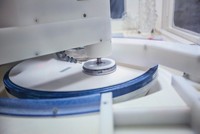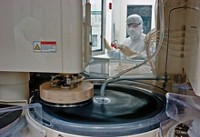Advertisement
Grab your lab coat. Let's get started
Welcome!
Welcome!
Create an account below to get 6 C&EN articles per month, receive newsletters and more - all free.
It seems this is your first time logging in online. Please enter the following information to continue.
As an ACS member you automatically get access to this site. All we need is few more details to create your reading experience.
Not you? Sign in with a different account.
Not you? Sign in with a different account.
ERROR 1
ERROR 1
ERROR 2
ERROR 2
ERROR 2
ERROR 2
ERROR 2
Password and Confirm password must match.
If you have an ACS member number, please enter it here so we can link this account to your membership. (optional)
ERROR 2
ACS values your privacy. By submitting your information, you are gaining access to C&EN and subscribing to our weekly newsletter. We use the information you provide to make your reading experience better, and we will never sell your data to third party members.
Business
Gary S. Calabrese
Rohm and Haas chief technology officer goes for the 'cool stuff'
by By Marc S. Reisch
April 3, 2006
| A version of this story appeared in
Volume 84, Issue 14
It is rare to hear the chief technology officer (CTO) of a major chemical company declare: "Our mission is to keep coming up with cool stuff on a regular basis." However, Gary S. Calabrese, vice president and CTO of Rohm and Haas, made just that statement last November at a conference on innovation in Cincinnati.
Many CTOs at the conference, jointly sponsored by the American Institute of Chemical Engineers and the American Chemical Society, would agree with the sentiment even though they might not say it in quite the same way. For Calabrese, the challenge is to take Rohm and Haas's 2006 R&D budget of $300 million, mobilize the firm's 2,000 scientists and technicians, and create the must-have specialty materials that customers in markets such as construction, electronics, packaging, and personal care will want to buy.
Calabrese attributes his use of the word "cool" to the fact that he has a teenager at home, so the language doesn't seem out of place to him. But Calabrese, 48, who earned a Ph.D. in inorganic chemistry from Massachusetts Institute of Technology, has another good reason to adopt the language of his offspring.
He has worked in and around the rapidly changing, youth-oriented electronics and semiconductor business since he first joined electronic chemicals firm Shipley in 1989. He continued working at Shipley in manufacturing and R&D positions after Rohm and Haas bought control of Shipley in 1992. In 2003, Calabrese became head of all R&D at Rohm and Haas, which had $8 billion in sales last year and where he retains oversight of the firm's electronic materials research organization.
"Cool" means "I want it now," explains Calabrese, who is also a member of C&EN's advisory board. "When you show something to a customer who asks, 'When can I have that?' then you know that customer is hungry for it and is going to want to pay for it."
Products enter and penetrate the market more quickly today than they did years ago, Calabrese says. For instance, it took about 90 years for the automobile to penetrate 50% of its potential market in the U.S., 45 years for electricity, about 25 years for television, and about 20 years for the personal computer, he points out. Businesses have to react more quickly today to get a share of fast-growing markets, he observes.
For the firm's electronic chemicals unit, that means Rohm and Haas has to continually develop new photoresists, which semiconductor makers use to create circuit lines on silicon chips. Improved photoresists not only drive down transistor costs, but also speed development of the latest electronic devices. "There are huge technology needs to do that. So when we put samples of photoresists into a customer's hands and he tests them and says, 'I want that one,' I define that as pretty cool. The customer is going to pay for that photoresist, and he is going to pay the kind of money we need to pay for our R&D and to keep our company growing profitably."
Product line extensions are one way to preserve and build the market share and profitability of an existing business. But entirely new product lines promise even greater profit potential, Calabrese says. And so between 1997 and 2005, spending on new product line creation rose from 11% to about 37% of the Rohm and Haas R&D budget, Calabrese says.
To create new product lines, sometimes the firm will buy technology and further develop it in-house. In 1997, it invested in the electronic chemicals firm Rodel and thereby gained entry in the market for chemical slurries and pads used to polish silicon wafers during semiconductor production. However, Calabrese says, when the firm does look for outside technology, "the norm for us is to buy pieces-licenses-to various things we need to add to what we already have" and so speed the development of desirable products.
Often Rohm and Haas will leverage its in-house technologies to create an entirely new product line. For instance, the company, well-known for its ion-exchange resin beads used to purify water, adapted the beads for sale to drugmakers to purify inhalable insulin. "We mobilized other chemistries on the surface of those beads to clean up the insulin and make it pure," he says. The Rohm and Haas resin beads replace silica previously used to purify not only insulin but also other peptides, small proteins, nucleic acids, and antibiotics.
New product lines such as the purification beads introduced over the past five years account for between 25 and 30% of the firm's gross profits, Calabrese says. "We'd like to push that number further north. We think it is healthy to have a rapid turnover," he adds.
The measure of gross profits from new products is not the only way in which Rohm and Haas quantifies the "must have" value of its coolest technologies. The firm also looks at things such as market share, the rate of entry into new product lines, and the pace of new product line growth.
But at the end of the year, that gross profit number needs to be high. Otherwise the firm's R&D mavens have not only failed in their mission to come up with cool stuff on a regular basis, but the firm's "competitors are gaining ground" too, Calabrese notes.






Join the conversation
Contact the reporter
Submit a Letter to the Editor for publication
Engage with us on Twitter